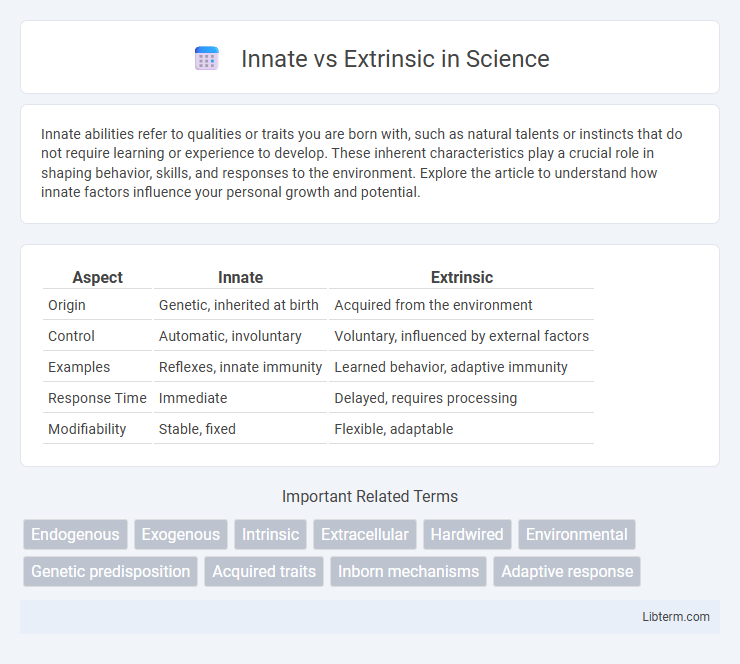Innate abilities refer to qualities or traits you are born with, such as natural talents or instincts that do not require learning or experience to develop. These inherent characteristics play a crucial role in shaping behavior, skills, and responses to the environment. Explore the article to understand how innate factors influence your personal growth and potential.
Table of Comparison
| Aspect | Innate | Extrinsic |
|---|---|---|
| Origin | Genetic, inherited at birth | Acquired from the environment |
| Control | Automatic, involuntary | Voluntary, influenced by external factors |
| Examples | Reflexes, innate immunity | Learned behavior, adaptive immunity |
| Response Time | Immediate | Delayed, requires processing |
| Modifiability | Stable, fixed | Flexible, adaptable |
Defining Innate and Extrinsic Traits
Innate traits are genetically inherited characteristics present from birth, such as eye color, blood type, and natural reflexes, defining an organism's biological foundation. Extrinsic traits develop through environmental interactions and experiences, including language skills, cultural behaviors, and learned habits, shaping an individual's adaptability and social identity. Understanding the distinction between innate and extrinsic traits is essential in fields like genetics, psychology, and evolutionary biology to analyze nature versus nurture influences.
Historical Perspectives on Innate vs Extrinsic
Historical perspectives on the innate versus extrinsic debate trace back to classical philosophy, where thinkers like Plato emphasized inherent knowledge, while Aristotle highlighted experiential learning. During the Enlightenment, figures such as John Locke advocated the tabula rasa concept, asserting that knowledge is primarily derived from sensory experience, contrasting with Descartes' belief in innate ideas. Modern psychological theories continue to explore this dichotomy through research on genetic predispositions versus environmental influences shaping human behavior and cognition.
Biological Foundations of Innate Abilities
Innate abilities are biologically grounded in genetic inheritance and neurodevelopmental processes that shape an individual's natural predispositions and reflexes, contrasting with extrinsic skills acquired through environmental interaction and learning. Key biological foundations include neural circuitry encoded by DNA, epigenetic modifications influencing gene expression, and evolutionary adaptations that enhance survival and cognitive function. Research highlights the role of prenatal brain development and synaptic plasticity in manifesting innate cognitive and behavioral traits, distinguishing them from skills shaped predominantly by external stimuli.
The Role of Environment in Extrinsic Development
Environmental factors play a crucial role in extrinsic development by shaping behaviors, skills, and cognitive functions through learning and experience. Nutritional status, social interactions, and cultural contexts significantly influence brain plasticity and emotional growth outside of genetic predispositions. Exposure to enriching or adverse environments during critical periods can enhance or hinder developmental outcomes, underscoring the significance of external conditions in shaping an individual's traits.
Nature vs Nurture: Key Debates
Innate traits are genetically inherited, originating from an individual's biological makeup, while extrinsic traits develop through environmental influences and learning experiences. The nature versus nurture debate centers on the extent to which genetics (nature) or environment (nurture) shape human behavior, intelligence, and personality. Research in epigenetics and behavioral genetics continually reveals complex interactions between inherited predispositions and external factors, emphasizing the dynamic relationship between innate and extrinsic influences.
Innate vs Extrinsic in Human Behavior
Innate human behavior is driven by genetic and biological factors hardwired into the brain, influencing instincts such as reflexes and basic emotional responses. Extrinsic behavior, in contrast, is shaped by environmental influences, learning experiences, and social interactions that modify or override innate responses. Understanding the interplay between innate predispositions and extrinsic factors is essential for fields like psychology and behavioral science to analyze human actions.
Case Studies: Real-World Examples
Case studies highlight the distinction between innate immunity, which provides immediate, non-specific defense mechanisms such as barriers and phagocytes, and extrinsic immunity involving adaptive responses like antibody production tailored to specific pathogens. For example, research on tuberculosis demonstrates how innate macrophage activity shapes initial infection control, while extrinsic T-cell responses contribute to long-term immunity. Studies on COVID-19 patients reveal variations in innate cytokine release and subsequent adaptive immune activation, emphasizing the dynamic interplay between these immune components in real-world disease outcomes.
Impact on Learning and Growth
Innate factors influence learning and growth by providing genetic predispositions that affect cognitive abilities and temperament, shaping how individuals absorb information and respond to challenges. Extrinsic factors, such as environmental stimuli, educational opportunities, and social interactions, play a crucial role in enhancing or hindering skill development and knowledge acquisition. The dynamic interplay between innate traits and extrinsic influences determines the overall trajectory of personal growth and learning effectiveness.
Psychological Theories Surrounding Innate and Extrinsic
Psychological theories surrounding innate and extrinsic factors emphasize the role of genetic predispositions and environmental influences in shaping human behavior and motivation. Innate theories, such as nativism, focus on inherited traits and instincts that guide development, while extrinsic theories highlight external rewards and social conditioning as drivers of behavior, exemplified by behaviorism and reinforcement models. Research integrating both perspectives suggests that optimal psychological functioning arises from the interaction between innate biological mechanisms and extrinsic environmental factors.
Implications for Future Research
Understanding the distinctions between innate and extrinsic factors is crucial for advancing research in genetics, developmental biology, and neuropsychology. Future studies should explore gene-environment interactions to clarify how intrinsic genetic predispositions and external environmental stimuli jointly influence behavior and disease susceptibility. Emphasizing epigenetic mechanisms may provide novel insights into how extrinsic factors modulate innate biological processes across the lifespan.
Innate Infographic

 libterm.com
libterm.com